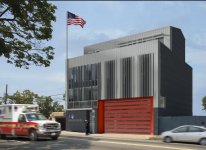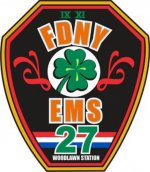FDNY EMS Station 27
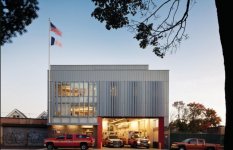
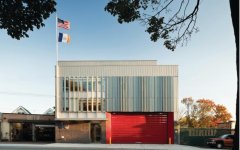
The Bronx neighborhood of Woodlawn is near enough to New York’s border that if you trip one way, you’ll fall over the city line. Trip another and you may hit your knee on a tombstone: 300,000 of them occupy Woodlawn Cemetery, on the area’s southern periphery.
Woodlawn’s living residents, outnumbered as they are, are a hearty bunch. Though living far from the bright lights of Manhattan, these mostly middle-class and immigrant strivers rely on municipal services provided by City Hall downtown. Now, with the arrival last August of an innovative Emergency Medical Services (EMS) station designed by New York–based WXY Architecture + Urban Design, Woodlawn has found itself with one of the brightest jewels in the city’s infrastructural crown.
“A lot of people in EMS, they think of this as being like the flagship station,” says lieutenant George Trager, a paramedic attached to the new EMS 27 on East 233rd Street. Before last summer, Trager and his 60-odd colleagues were scattered in facilities across the city, many of which were cramped, aging, and inadequate. The difference between their old and new digs, says the 16-year veteran, is “like night and day.”
EMS stations are peculiarly hybrid creatures. Combining various elements of a firehouse, a clubhouse, and a parking garage, they have to serve as all-purpose depots for roving bands of EMTs and paramedics on 24-hour patrol. Ambulances return to refuel and resupply; crews check in at the beginning and end of each eight-hour shift, and senior staff stop by to monitor operations in the field.
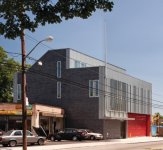
For the new Bronx location, the designers and assorted governmental stakeholders were charged with stuffing these complex functions into a very tight envelope. EMS 27 occupies a footprint of less than 3,000 square feet and is wedged between an auto shop and a dusty scrap lot. Like the nearly century-old fire station it replaces, the new building runs through the narrow block from front to back, facing onto a high-traffic corridor on one side, and a quiet residential stretch of Woodlawn on the other.
Claire Weisz, AIA, founding principal (with partner Mark Yoes, AIA) of WXY, was acutely sensitive to this contextual double bind. “We were concerned that the neighborhood, which had fought for this building, didn’t end up with the same façades for both the houses and the [main] road,” she says. Accordingly, EMS 27 presents two faces to the world: to its neighbors, it’s a demure composition of glass and zinc panels, easily mistaken for a contemporary condominium; for drivers on the busy thoroughfare, its row of raked, irregular louvers establishes a lively play of sun and shadow that’s even more striking at 40 miles an hour.
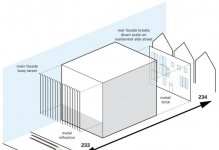
The shimmering brise soleil, hoisted over a base of glazed brick, helps to mask a complex mechanical system that nearly bursts out of the building frame. “No inch of the building is wasted here,” notes Samir Shah, program director for the Department of Design and Construction (DDC), the city’s representative on the project. Everything from a control booth and computer room, to decontamination units, to a narcotics storage closet with a blood-vessel-scanning lock are all stacked one atop the other on the building’s five above- and below-ground floors. A training room that doubles as a dining space in the penthouse and a connecting outdoor terrace (unique to New York’s EMS stations) add just a touch of luxury, as does a fitness room below—though all, in an ironic instance of momento mori, command sweeping views of the nearby graveyard.
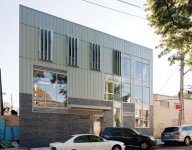
The building’s height, itself unusual for an EMS station, gave WXY the chance to make a virtue of the difficult site and hefty program. “By being that compact,” Weisz says, the EMTs “get to realize more social engagement.” By that, she means that the station’s overlapping functions—punctuated in WXY’s scheme by internal overlooks and atria—foster human interaction. The same applies outside the building’s walls, which the architects strove to open up with more apertures, more glass, and less bricks and mortar. “At the same time we were trying to make this a private space, we didn’t want to isolate them [the personnel] from the neighborhood,” she says. “We had to make that leap.”
Project Credits
Project EMS 27, Bronx, N.Y.
Client FDNY; consultant contract was held by NYC Department of Design and Construction
Architect WXY Architecture + Urban Design, New York—Claire Weisz, AIA, Mark Yoes, AIA, Layng Pew, AIA (principals); Adriel Mesznik, Christopher Kupski, Severn Clay, Justus Asselmeyer (key personnel)
Mechanical/Electrical Engineer Buro Happold—Michael McGough (engineer of record)
Structural Engineer Buro Happold—Craig Schwitter (engineer of record)
Civil Engineer HAKS—Ken Mangam (engineer of record)
